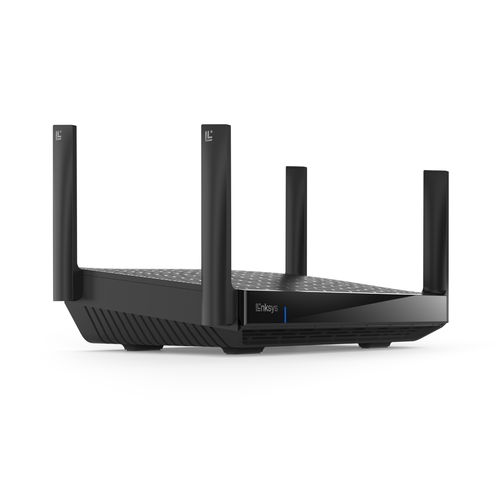Single-Band, Dual-Band, and Tri-Band WiFi Routers. What's the Difference?

Comparing single-, dual-, and tri-band routers isn't as easy as comparing a single-patty hamburger with a triple-decker. Though "more is better" is easy enough for some comparisons, the world of WiFi is a bit more nuanced when it comes to meeting your specific needs.
So let's talk about bands. Once you plug your network cable into a WiFi router, the radio waves that wirelessly transmit an Internet signal to your iPhone or Xbox travel on one of two frequency bands: 2.4 GHz and 5 GHz. It's these different frequencies that separate a single-band router from a dual-band, and makes tri-band routers distinct from both. But the WiFi rabbit hole goes even deeper still.
Single-Band Routers: Affordable, but Limited
Way back in 1999, the Institute of Electrical and Electronics Engineers (IEEE) introduced the idea of wireless standards—that's what those "802.11" numbers that you see on your WiFi-enabled gear represent. These standards are basically rule books that make sure routers and online devices are on the same page, ensuring that your Roku plays just as nicely with your router as your tablet does.
A single-band router is limited to, as you might've guessed, just one frequency band—the 2.4 GHz frequency band, to be exact. Older, single-band routers operate on the 802.11g standard (introduced in 2003), which caps data speeds at 54 Mbps. The iPhone 3G and 3Gs use this standard, for instance.
More likely, though, a single-band router operates on the (somewhat) newer 802.11n standard, also known as "Wireless-N." Wireless-N routers on a 2.4 GHz band offer theoretical speeds of up to 800 Mbps—"theoretical" meaning that you'll probably never see these speeds during day-to-day use, given real-world factors such as your Internet service limitations.
Though single-band, 2.4 GHz routers are accessible and low-priced, they come with a fair share of drawbacks, given the natural progression of WiFi tech. It breaks down something like this:
Single-Band Pros
- Low purchase price
- Compatibility with almost all devices, as multi-band devices typically support 2.4 GHz connections (but not vice versa)
- Lower frequency is better at penetrating obstacles such as walls, doors, furniture, etc.
Single-Band Cons
- Lower maximum speeds than multi-band alternatives
- Given the age and ubiquity of 2.4 GHz devices, you'll likely experience lots of signal interference, which can reduce WiFi speed and stability
- Single-band routers won't include modern features, like app-based monitoring or device prioritization
Dual-Band Routers: A Smart Middle Ground
In addition to supporting the 2.4 GHz Wireless-N standard, dual-band routers support the 5 GHz frequency band, operating on the newer 802.11ac standard. At their theoretical best, that means they support aggregate speeds up to 2,167 Mbps or more.
For most households, 5 GHz connectivity is what makes these routers really shine. Imagine that the 2.4 GHz and 5 GHz bands are freeways, and each of the WiFi networks in your router's vicinity are semi-trucks. Having been around for more than a decade, there are a whole lot of 2.4 GHz semi-trucks out there, and that makes for speed-clogging traffic jams. On the other hand, the 5 GHz freeway is fairly open because it’s newer, making for a faster, more stable connection. This is especially crucial if you live in a well-populated city or a big apartment building.
Some dual-band routers also pack perks that you won't find on older models. For instance, many support MU-MIMO technology, which improves the way your WiFi interacts with multiple devices. Routers without MU-MIMO can pay attention to only a single device at once—you can still use multiple devices, but imagine your router is on a lazy Susan, sending data to your smart TV, your gaming console, and your laptop in turn as the platter spins. The more devices you have, the less data they're going to catch, so to speak.
In contrast, MU-MIMO maintains a constant connection to multiple devices simultaneously, so even when you're streaming Spotify while your kids are playing Splatoon in the next room, the Internet connection runs smoothly.
Dual-Band Pros
- Being the current market standard, dual-band routers might surpass their single-band cousins in cost, but they still sport entry-level prices
- With more modern hardware, dual-band routers offer more range and stability than singe-band routers
- Compatibility with recent 5 GHz-friendly devices, such as the Google Pixel, iPhone 7, and PlayStation 4 Pro
- Twice the bandwidth of single-band routers (or more)
Dual-Band Cons
- Though you're much more likely to experience interference on the 2.4 GHz band, the 5 GHz band will continue to become more populated over time
- Speeds are impacted by the amount of connected devices using WiFi at once
- 5 GHz has a shorter range than 2.4 GHz in environments with lots of obstacles such as walls, doors, furniture, etc.
Tri-Band Routers: Future Proofing for Power Users
Right off the bat, tri-band routers—which just hit the scene a few years ago—are capable of multiple Gigabit speeds, up to 2166 Mbps on each 5 GHz band. And here's where the "tri" in "tri-band" comes into play: They feature one 2.4 GHz band and two 5 GHz bands.
With two radio freeways for your 5 GHz data to travel on, tri-band routers reduce signal interference even more than dual-band devices. Using automated features like Linksys Smart Connect, tri-band routers "steer" devices to the optimal 5 GHz band (or the applicable 2.4 GHz band, for older devices). It's kind of like adding an extra lane to the interstate, or a bike lane to downtown roads—this makes tri-brand routers a handy tool for environments with a lot of continuously connected 5 GHz devices, and a worthy investment if you're currently on the market for a new router and want to future-proof your WiFi for at least a few years.
Tri-Band Pros
- More connected devices are less likely to negatively affect WiFi speeds
- Three separate WiFi bands means three times the bandwidth
- You can dedicate each band to devices in the home or office
- More bands equals less interference
- High CPU speeds make faster file transfers and smoother handling of multiple WiFi-connected devices
Tri-Band Cons
- Significantly higher cost than dual-band models
- If you don't have a lot of 5 GHz-compatible WiFi devices, the upgrade might not be too noticeable
Take note of that last bit—if you're in a studio apartment rocking a laptop, a smartphone, and a gaming console, sticking with your dual-band router is probably a safe bet. But if you plan on Netflix-ing 4K movies downstairs while your spouse streams recipe videos from a tablet in the kitchen, your kid's Pandora station never stops, and your guest harbors a World of Warcraft addiction, it might just be time to add that third traffic lane to your home's WiFi freeway.

